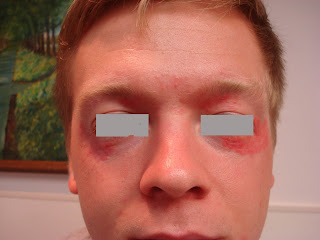O/E: Florid erythema of face and neck. Submental area does not appear to be spared.
This woman has a somewhat "leonine" facies.
Diagnosis: Initially, I thought she had a contact dermatitis or the "red face syndrome" from overuse of topical corticosteroids. She has been off the latter for > 1 year. The has needed prednisone to control this; but I prefer a long-term medication with less side-effects. Given her history of lymphoma, further evaluation may be necessary.
References:
Azathioprine versus betamethasone for the treatment of
parthenium dermatitis: a randomized controlled study.
Verma KK1, Mahesh R, Srivastava P, Ramam M, Mukhopadhyaya
AK.
Indian J Dermatol Venereol Leprol. 2008 Sep-Oct;74(5):453-7
Author information: prokverma@hotmail.com
Abstract
CONCLUSIONS: Azathioprine and betamethasone appear to be
almost equally effective (P=0.0156 vs. 0.0005) in the treatment of parthenium
dermatitis. However, adverse effects and relapses were observed to be more
frequent in patients treated with betamethasone. Free Full Text







